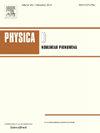高阶时间网络驱动的流行病时空扩散模型动态分析与控制
IF 2.9
3区 数学
Q1 MATHEMATICS, APPLIED
引用次数: 0
摘要
信息在预防和管理传染病方面发挥着至关重要的作用,但它也可能加速传染病的传播。本研究在现有复杂网络的基础上构建了多个高阶网络。基于unaware - aware - aware - unaware -易感者-暴露者-感染者-恢复者-易感者(UAU-SEIRS)框架,构建了信息传播与疫情传播相结合的高阶时间复用网络,以准确描述信息传播与疫情传播的动态过程。此外,我们导出了流行病阈值的表达式,以确定流行病爆发的临界条件。信息传播层的高阶交互作用使流行阈值增大,而传播层的高阶交互作用使流行阈值减小。我们进一步考虑了出生和死亡,构建了一个高阶时空网络动力学系统。随后,我们研究了高阶系统中的图灵不稳定性判据,以研究流行病在空间中传播的模式形成机制。增加低阶相互作用和降低耦合函数的阶数会导致图灵不稳定性。高阶邻接矩阵的定义和高阶网络的生成方法对感染个体的分布有重要影响。此外,我们提出了一种资源约束下的最优控制策略,旨在通过调整隔离措施来有效控制疫情的传播,并验证了其延迟疫情传播的有效性。最后,SEIRS系统可以有效地容纳中国累积猴痘感染数据。本文章由计算机程序翻译,如有差异,请以英文原文为准。
Dynamic analysis and control of the spatiotemporal epidemic diffusion model driven by higher-order temporal networks
Information plays a crucial role in the prevention and management of infectious diseases, but it can also potentially accelerate their spread. This study constructs multiple higher-order networks based on existing complex networks. We construct a higher-order temporal multiplex network that integrates information diffusion and epidemic spreading, based on the Unaware–Aware–Unaware–Susceptible–Exposed–Infected–Recovered–Susceptible (-) framework, to accurately describe the dynamic processes of information propagation and epidemic spreading. Additionally, we derive an expression for the epidemic threshold to determine the critical conditions for the epidemic outbreak. Higher-order interactions in the information dissemination layer increase the epidemic threshold, while higher-order interactions in the epidemic spread layer decrease the epidemic threshold. We further consider births and deaths and construct a higher-order spatiotemporal network dynamics system. Subsequently, we investigate the Turing instability criteria in the higher-order system to study the pattern formation mechanisms of epidemic spreading in space. Adding lower-order interactions and reducing the order of the coupling function leads to Turing instability. The definition of the higher-order adjacency matrix and the generation method of higher-order networks significantly influence the distribution of infected individuals. Additionally, we propose an optimal control strategy under resource constraints aimed at effectively controlling epidemic spreading by adjusting isolation measures and verify its effectiveness in delaying epidemic spread. Finally, the system can effectively accommodate China’s cumulative monkeypox infection data.
求助全文
通过发布文献求助,成功后即可免费获取论文全文。
去求助
来源期刊

Physica D: Nonlinear Phenomena
物理-物理:数学物理
CiteScore
7.30
自引率
7.50%
发文量
213
审稿时长
65 days
期刊介绍:
Physica D (Nonlinear Phenomena) publishes research and review articles reporting on experimental and theoretical works, techniques and ideas that advance the understanding of nonlinear phenomena. Topics encompass wave motion in physical, chemical and biological systems; physical or biological phenomena governed by nonlinear field equations, including hydrodynamics and turbulence; pattern formation and cooperative phenomena; instability, bifurcations, chaos, and space-time disorder; integrable/Hamiltonian systems; asymptotic analysis and, more generally, mathematical methods for nonlinear systems.
 求助内容:
求助内容: 应助结果提醒方式:
应助结果提醒方式:


